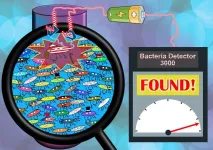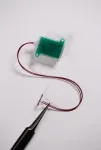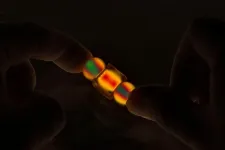(Press-News.org) Each year, bacterial infections claim several million lives worldwide. That is why detecting harmful microorganisms is crucial – not only in the diagnosis of diseases but also, for example, in food production. However, the methods available so far are often time-consuming, require expensive equipment or can only be used by specialists. Moreover, they are often unable to distinguish between active bacteria and their decay products.
By contrast, the newly developed method detects only intact bacteria. It makes use of the fact that microorganisms only ever attack certain body cells, which they recognize from the latter’s specific sugar molecule structure. This matrix, known as the glycocalyx, differs depending on the type of cell. It serves, so to speak, as an identifier for the body cells. This means that to capture a specific bacterium, we need only to know the recognizable structure in the glycocalyx of its preferred host cell and then use this as “bait”.
This is precisely what the researchers have done. “In our study, we wanted to detect a specific strain of the gut bacterium Escherichia coli – or E. coli for short,” explains Professor Andreas Terfort from the Institute of Inorganic and Analytical Chemistry at Goethe University Frankfurt. “We knew which cells the pathogen usually infects. We used this to coat our chip with an artificial glycocalyx that mimics the surface of these host cells. In this way, only bacteria from the targeted E. coli strain adhere to the sensor.”
E. coli has many short arms, known as pili, which the bacterium uses to recognize its host’s glycocalyx and cling onto it. “The bacteria use their pili to bind to the sensor in several places, which allows them to hang on particularly well,” says Terfort. In addition, the chemical structure of the artificial glycocalyx is such that microbes without the right arms slide off it – like an egg off a well-greased frying pan. This ensures that indeed only the pathogenic E. coli bacteria are retained.
But how were the scientists able to corroborate that bacteria really were attached to the artificial glycocalyx? “We bonded the sugar molecules to a conductive polymer,” explains Sebastian Balser, a doctoral researcher under Professor Terfort and the first author of the paper. “By applying an electrical voltage via these ‘wires’, we are able to read how many bacteria had bonded to the sensor.”
The study documents how effective this is: The researchers mixed pathogens from the targeted E. coli strain among harmless E. coli bacteria in various concentrations. “Our sensor was able to detect the harmful microorganisms even in very small quantities,” explains Terfort. “What’s more, the higher the concentration of the targeted bacteria, the stronger the emitted signals.”
The paper is initial proof that the method works. In the next step, the involved working groups want to investigate whether it also stands the test in practice. Using it in regions where there are no hospitals with sophisticated lab diagnostics is conceivable, for example.
Picture download:
https://www.puk.uni-frankfurt.de/151323552?
Caption: By using a customized surface to bait the targeted pathogens, they separate by themselves from a mixture of many different bacteria. This makes it easy to detect them electrochemically.
Diagram: Sebastian Balser, Andreas Terfort Research Group, Goethe University Frankfurt
Further information
Professor Andreas Terfort
Institute of Inorganic and Analytical Chemistry
Goethe University Frankfurt
Tel.: +49 (0)69 798-29181
aterfort@chemie.uni-frankfurt.de
Website: https://www.uni-frankfurt.de/53459866/Arbeitskreis_Prof__Andreas_Terfort
Twitter/X: @goetheuni
END
Novel electrochemical sensor detects dangerous bacteria
Researchers at Goethe University Frankfurt and Kiel University have developed an innovative detection method
2024-03-25
ELSE PRESS RELEASES FROM THIS DATE:
Cancer therapies show promise in combating tuberculosis
2024-03-25
EMBARGOED UNTIL MARCH 25, 2024 AT 3:00 PM US EST
What could cancer teach us about tuberculosis? That’s a question Meenal Datta has been chasing since she was a graduate student.
Once the body’s immune system is infected with tuberculosis, it forms granulomas — tight clusters of white blood cells — in an attempt to wall off the infection-causing bacteria in the lungs. But more often than not, granulomas do more harm than good.
Charged with analyzing the similarities between granulomas and tumors, Datta discovered that both are structurally and functionally abnormal. ...
Gotta go? New bladder device lets you know
2024-03-25
Should you run to the bathroom now? Or can you hold it until you get home? A new implant and associated smartphone app may someday remove the guess work from the equation.
Northwestern University researchers have developed a new soft, flexible, battery-free implant that attaches to the bladder wall to sense filling. Then, it wirelessly — and simultaneously — transmits data to a smartphone app, so users can monitor their bladder fullness in real time.
The study will be published next week in the Proceedings of the National Academy of Sciences (PNAS). It ...
Seeing the forest for the trees: Species diversity is directly correlated with productivity in eastern U.S. forests
2024-03-25
When scientists and policymakers make tough calls on which areas to prioritize for conservation, biodiversity is often their top consideration. Environments with more diversity support a greater number of species and provide more ecosystem services, making them the obvious choice.
There’s just one problem. There are several ways to measure diversity, and each reveals a slightly different, and sometimes conflicting, view of how life interacts in a forest or other ecosystem.
In a new study published ...
Pairing crypto mining with green hydrogen offers clean energy boost
2024-03-25
ITHACA, N.Y. – Pairing cryptocurrency mining – notable for its outsize consumption of carbon-based fuel – with green hydrogen could provide the foundation for wider deployment of renewable energy, such as solar and wind power, according to a new Cornell University study.
“Since current cryptocurrency operations now contribute heavily to worldwide carbon emissions, it becomes vital to explore opportunities for harnessing the widespread enthusiasm for cryptocurrency as we move toward a sustainable and a climate-friendly future,” said Fengqi You, professor of energy systems engineering at Cornell.
You and doctoral ...
With a new experimental technique, MIT engineers probe the mechanisms of landslides and earthquakes
2024-03-25
Granular materials, those made up of individual pieces, whether grains of sand or coffee beans or pebbles, are the most abundant form of solid matter on Earth. The way these materials move and react to external forces can determine when landslides or earthquakes happen, as well as more mundane events such as how cereal gets clogged coming out of the box. Yet, analyzing the way these flow events take place and what determines their outcomes has been a real challenge, and most research has been confined to two-dimensional experiments that don’t ...
MinJun Kim inducted into the 2024 Class of the AIMBE College of Fellows
2024-03-25
The American Institute for Medical and Biological Engineering (AIMBE) has announced the induction of MinJun Kim, Robert C. Womack Endowed Chair Professor in Engineering at Southern Methodist University to its College of Fellows.
Election to the AIMBE College of Fellows is among the highest professional distinctions accorded to medical and biological engineers, comprised of the top two percent of engineers in these fields. College membership honors those who have made outstanding contributions to "engineering and medicine research, practice, or education” and to “the pioneering of new and developing fields of technology, making major advancements in traditional ...
Global study could change how children with multiple sclerosis are treated
2024-03-25
A ground-breaking study – the largest of its kind globally – has found children with multiple sclerosis (MS) have better outcomes if treated early and with the same high-efficacy therapies as adults.
There are a limited number of therapies approved for children with MS, with only one considered to be of high-efficacy – meaning highly effective.
However, a Royal Melbourne Hospital (RMH) observational study has determined that paediatric patients should be treated with the same high-efficacy ...
NRL scientists deliver quantum algorithm to develop new materials and chemistry
2024-03-25
WASHINGTON – U.S. Naval Research Laboratory (NRL) scientists published the Cascaded Variational Quantum Eigensolver (CVQE) algorithm in a recent Physical Review Research article, expected to become a powerful tool to investigate the physical properties in electronic systems.
The CVQE algorithm is a variant of the Variational Quantum Eigensolver (VQE) algorithm that only requires the execution of a set of quantum circuits once rather than at every iteration during the parameter optimization process, thereby increasing the computational throughput.
“Both algorithms ...
Bengal cat coats are less wild than they look, genetic study finds
2024-03-25
Bengal cats are prized for their appearance; the exotically marbled and spotted coats of these domestic pets make them look like small, sleek jungle cats. But the origin of those coats — assumed to come from the genes of Asian leopard cats that were bred with house cats — turns out to be less exotic.
Stanford Medicine researchers, in collaboration with Bengal cat breeders, have discovered that the Bengal cats’ iridescent sheen and leopard-like patterns can be traced to domestic cat genes that were aggressively selected for after the cats were bred with wild cats.
“Most ...
Transmasculine people report higher dietary supplement use than general population
2024-03-25
More than 1 million people in the United States identify as transgender; however, there is limited research on nutrition-related health outcomes for transgender people. To narrow the research gap, Mason MS, Nutrition student Eli Kalman-Rome investigated common motivations of dietary supplement use in transmasculine people. The study defined transmasculine as people on the transgender and gender-nonbinary spectrum who were assigned female at birth.
Transmasculine people reported a higher use of dietary supplements (65%) compared to the total U.S. population (22.5%), according to the study. 90% of transmasculine participants reported using supplements ...
LAST 30 PRESS RELEASES:
Norbert Holtkamp appointed director of Fermi National Accelerator Laboratory
New agentic AI platform accelerates advanced optics design
Biologists discover neurons use physical signals — not electricity — to stabilize communication
Researchers discover that a hormone can access the brain by hitchhiking
University of Oklahoma researcher awarded funding to pursue AI-powered material design
Exploring how the visual system recovers following injury
Support for parents with infants at pediatric check-ups leads to better reading and math skills in elementary school
Kids’ behavioral health is a growing share of family health costs
Day & night: Cancer disrupts the brain’s natural rhythm
COVID-19 vaccination significantly reduces risk to pregnant women and baby
The role of vaccination in maternal and perinatal outcomes associated with COVID-19 in pregnancy
Mayo Clinic smartwatch system helps parents shorten and defuse children's severe tantrums early
Behavioral health spending spikes to 40% of all children’s health expenditures, nearly doubling in a decade
Digital cognitive behavioral treatment for generalized anxiety disorder
Expenditures for pediatric behavioral health care over time and estimated family financial burden
Air conditioning in nursing homes and mortality during extreme heat
The Alps to lose a record number of glaciers in the next decade
What makes a good proton conductor?
New science reporting guide published for journalists in Bulgaria
New international study reveals major survival gaps among children with cancer
New science reporting guide published for journalists in Turkey
Scientists develop a smarter mRNA therapy that knows which cells to target
Neuroanatomy-informed brain–machine hybrid intelligence for robust acoustic target detection
Eight SwRI hydrogen projects funded by ENERGYWERX
The Lundquist Institute and its start-up company Vitalex Biosciences Announces Strategic Advancement of Second-Generation fungal Vaccine VXV-01 through Phase 1 Trials under $40 Million Competitive Con
Fine particles in pollution are associated with early signs of autoimmune disease
Review article | Towards a Global Ground-Based Earth Observatory (GGBEO): Leveraging existing systems and networks
Penn and UMich create world’s smallest programmable, autonomous robots
Cleveland researchers launch first major study to address ‘hidden performance killer’ in athletes
To connect across politics, try saying what you oppose
[Press-News.org] Novel electrochemical sensor detects dangerous bacteriaResearchers at Goethe University Frankfurt and Kiel University have developed an innovative detection method







